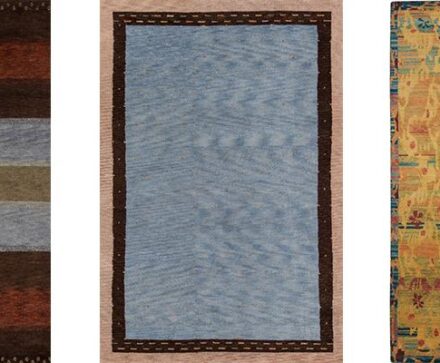How to Choose a Rug Material
Rugs are made of many different types of materials, and what material is used plays a significant role in the quality and longevity of the rug. There’s more to choosing rug materials than what meets the eye! Here’s what you need to know.
John Maher: Hi, I’m John Maher and I’m here today with Sam Presnell, owner of the Rug Gallery, an oriental rug company and carpet store in Cincinnati, Ohio. Today we’re talking about rug materials. Welcome, Sam.
Sam Presnell: Hello, John.
Rug Materials for Stain Resistance
John: Sam, what is the best fiber for rugs in terms of stain resistance?
Sam: Today, there are lots of fibers and there are a lot of claims about stain resistance. Usually today the two best fibers for stain resistance is usually a fiber called nylon or polypropylene. Nylon really is coated with a sealant like a 3M product that you might know that you can buy off a shelf, which would be a stain guard or a stain resistance. The other is polypropylene, which is basically a material that cannot absorb. It’s an inert material, which basically means it’s almost stain proof. Those are both very popular fibers. A lot in carpeting not so much in rugs, but there’s a fair amount in rugs today as well.
Viscose & Silks
John: What are viscose, art silks, bamboo silks, things like that and do you recommend them?
Sam: I have to say that probably one of my pet peeves is how much attention this product’s getting and when they use the word bamboo, people think of something very strong and hard. That it’s going to perform beautifully and be like a rock or piece of wood or whatever. It’s far from it with viscose, bamboo, or art silk. A lot of people call them silk and they’re not really silk. They are basically a cellulose or a pulp type of material made from plant materials, like you would make paper and things like that out of. They extrude into very fine filaments and when you put it into a rug it looks fantastic. You just got to have it. It looks better than silk. I really believe that when it’s new, but the problem is that that’s a product that I think is assumed to be something that isn’t. It should not be used in high traffic. It’s a very difficult product to clean. It tends to bleed in washing, it water stains or marks if you spill anything on it. It’s very absorbent as I’ve talked about. I would not highly recommend it even though we sell it. I just always tell the staff here is to don’t oversell it and to explain it for what it is, what [the consumer should] expect. Also, I don’t recommend it for certain situations or certain families that are expecting more than they’re going to get.
Are Wool Rugs the Best?
John: I’ve heard that wool rugs are the best. Is that true and why?
Sam: As a whole, yes, but as we all know not everything is that simple especially in fiber and carpet business. Same with any kind of business. There are lots of things that can change that. Wool is the tried and true [material for making a rug.] It’s been around since the beginning of man and we made rugs for at least five or six thousand years that I’m aware of, but not all wools are the same. There’s very short strands, or short fibers we call them, which means that they’re very small pieces. You can imagine you’re trying to spin small pieces of hair or fiber together. They’re not going to lock down. You get really long pieces. Let’s say you got a foot, foot and a half, foot piece of wool or hair. You start spinning it together. It gets really tight. It’s like a cable wire. The higher the staple we call it, or the longer the strands are, usually the better it can twist and the more it’s going to perform. It’s going to take all the air out of it and it’s going to wear a lot better as well as be something that’s going to look good long term. It’s not going to shed as much either.
John: Does that come from [the actual sheep shearing process?] Do they sometimes shear the sheep too soon so those wool fibers are too short and, like you said, they’re just too short, and they don’t spin together very well? Sam: That’s exactly what happens. You have a lot of countries that are very arid and they’re sheep herding countries. They raise a lot of sheep and a lot of stress is put on them to make money so they’re going to shear more often, maybe more than they should. Most people think the spring shearing is the best because you got through the winter and that’s the longest staple coat, but they also will shear right before fall before winter sets and at that point have a shorter staple yarn to use as well. It depends on pressure, it depends on how much money they need and what kind of fiber they want to put on the market. Also, you got to remember that other things count, such as a diet of the sheep [and their health.] That is also very important. Is the climate cold or cool? That is also going to make it grow longer. There are other things that can play into wool to make it better or perform better.
John: I never would have thought that the diet of the sheep could actually affect the condition of my rug.
Sam: It can definitely. It’s like people. People who don’t have good health, you’ll see their hair is usually one of the telltale signs that there are some other issues.
Does Wool Stain?
John: What about staining on wool? Can you talk about that a little bit?
Sam: That’s the big knock on wool. I got to say it would be the perfect fiber if it wasn’t so stainable and that’s something that’s inherited. You just can’t change it. Wool will absorb like 30 percent of its weight in moisture or water. It will be more absorbent. Usually it will stay on, by something tight enough, the surface for a long period of time before absorbed. It has a natural scale composition or cell composition that repels wetness and staining, but if it gets there long enough it will [soak in.] The real key is to act quickly and usually just soap and water or just some club soda will bring it to the top and just mop it up and that’s usually [all that is needed.] That’s usually the best thing is speed. There are other things you can buy after market, which basically you can Scotch Guard or fiber seal, which will help prevent things from absorbing, but again, it’s just topical on the tips. It’s not something that sits there long enough, finds a little nook or cranny that it won’t come in and wick out from the bottom or from the side or whatever into the fibers. It’s not like putting a piece of glass on it, but it does help as far as stain resistance too. The big thing is cleaning quickly, be prepared to clean, and know what to do.
John: That’s great advice. Sam Fresno, thanks again for speaking with me today.
Sam: You’re welcome, John. Thank you.
John: For more information about oriental rugs and carpets visit ruggallerycinci.com or call 513‑793‑9505.

